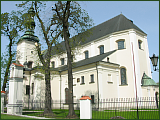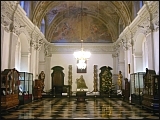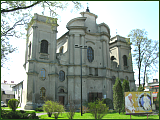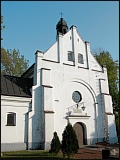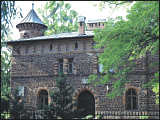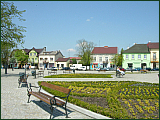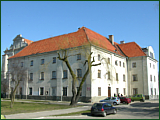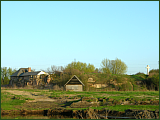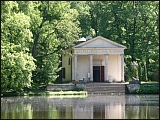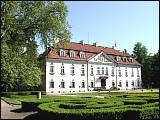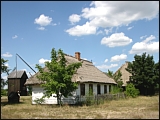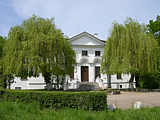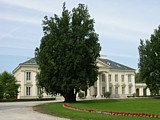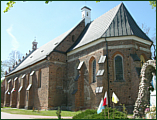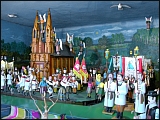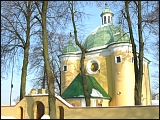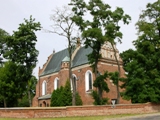IN ŁOWICZ
Cathedral – according to the inscription under the gallery, the church was there in 1100. In 1433 it was given a dignity of the collegiate church. In the middle of the 15th c. the primate Maciej Łubieński established the collegiate church the cathedral, and during the Pope's visit in 1999 the church received the name of basilica. Inside Renaissance and Baroque. 12 primates were buried there; 5 primates' chapels. Chapel of the Holiest Sacrament founded by archbishop Lipski – late Baroque polychromy by Adam Swach, an altar designed by Jakub Fontana. Chapel of Crucified Jesus founded by archbishop Komorowski – inside an altar with crucifix and a sarcophagus - a tombstone with a sculpted decoration by J.Ch. Redler. Other chapels; of St Wiktoria – Renaissance (founded by primate J. Uchański, built by J. Michałowicz ); of St Anna – founded by archbishop J. Wężyk with altars of St Nepomucen and of St Anna; ceiling decoration of the Lublin type; of the Holy Trinity- founded by J. Tarnowski with an early Baroque altar.
Former House of the Congregation of Missionary Fathers - nowadays a museum. Founded by archbishop M. Radziejowski according to a design by Tylman from Gameren, a chapel of Karol Boromeusz, late Baroque, with a polychromy by M. A. Palloni. Upstairs historical section with valuable souvenirs remembering splendour of Łowicz; on the second floor ethnographical section showing Łowicz folklore: characteristic striped clothes embroideries, weaving, paper cut-outs, furniture and sculpture. In the garden a small skansen with Łowicz farms and a coach house.
Piarist Church – late Baroque, three-nave; inside polychromy by Palloni, side altars with figures by Plersh, frescoes by Limecki or Palloni. Monastery founded in 1668 had a college, rich library, theatre band, and printing firm. The church was used as the hospital for prisoners of war and military storehouse.
Church of St Leonard – late Renaissance, nowadays an academic church; originally wooden then partly brick; rebuilt about 1642, founded by A. K. Cebrowski. There was a church and Institute of St Leonard taking care for poor boys, called Bartoszki. In 1780 there was established the first cemetery in Poland which was situated at the outskirts.
Architectural complex of general Klicki – a palace, a turret, a house of a caretaker, and a chapel erected about 1824 by K. Krauze. General Klicki was the participant of the battles for independence, from the „barska" confederation until the November Uprising; the commander of a division of mounted riflemen („szaser") stationed in Łowicz. Nowadays the Modern Painting Gallery of Z. Artymowska.
The New Market – the medieval urban plan preserved; three-cornered market is a unique specimen on a European scale. There was a Gothic Town Hall from 1443 in the middle; it was ruined in the 20s. of the 19 c. At present tenement-buildings from the 16-19th c. In the northern part – a stone commemorating Insurgents from 1863.
Ruins of the primates castle preserved remains of foundations of the Gothic upper castle from the times of archbishop Jarosław Skotnicki (about 1355); the residence of primates of I Republic, the guests were Kings: Kazimierz the Great, Zygmunt August, Zygmunt III Waza. The castle was destroyed at the time of Swedish invasion, further it was destroyed by Prussians.
IN ŁOWICZ REGION
Arkadia – sentimental-romantic English park founded in 1778 by the duchess – Helena Radziwiłł. In the park romantic pavilions designed by Sz.B. Zug; among them; Gothic Cottage with Sybilla’s cave, Diana’s sanctuary, and inside plafond by J.P. Norblin. The best preserved romantic park in Europe.
Nieborów – park-palace residence designed by Tylman von Gameren, founded by archbishop Radziejowski. From 1774 it was the Radziwiłł estate. M.H. Radziwiłł gathered a collection of paintings made by European masters of art, organized the library of old prints; decorative and applied art. In the southern part - the English park, next to the palace a lot of farm buildings: brewery, kitchen, hunter's pavillion, orangery. In the building of former brewery the exhibition of majolica.
Skansen Museum in Maurzyce. Ethnographic Park divided into 2 parts: one presents villein village from the 18th and 19th c. and the village from the 19th and 20th c.
Kiernozia – former town, the birthplace of M. Łączyńska, later Madame Walewska; her body brought from Paris was probably buried in the crypt of the church; church from the 16th c., interior from the 16-18th c. Łączyński palace with the park from the 19th c.; in the park the mound in the memory of T. Kościuszko.
Walewice – Classical palace of king chamberlain - Anastazy Walewski, outbuilding, stables and coach-house. There lived Maria nee Łączyńska Walewska, famous for her beauty, socalled „Napoleon’s Polish wife"; there was born Napoleon’s natural son - Aleksander. At present there is a stable, in the palace one can hire the guest rooms available for tourists. In the vicinity a geological reserve „Walewice" presenting sediments of glacial period. At the time of establishing it was the only reserve of this sort all over the world.
Bielawy – former a small town, from the 15th c., famous for its splendid beer; Gothic church from the 15th c. inside polychromy by Zofia Baudouin de Courtnay. Nearby a wooden belfry from the 18th c. and bell from 1531. The cemetery of Napoleon soldiers and insurgents from 1863, also the cemetery of soldiers killed in the battle upon Bzura. In nearby Mroga the classicist mansion.
Domaniewice – Baroque chapel from 1631-33 was built by citizens of Cracow – Wojciech and Jakub Celest. Inside a magnificent painting of Our Lady which imitates the painting of Our Lady from Rome; on a gallery two hundred year, seven-tone organs with a very interesting design: It depicts a silver eagle in a crown with the stretched wings; the most interesting organ designs in the world. An extensive wooded ridge, consists ot three banks built of gravel and sand, settled at the time of glaciation. Stone rings and frosty chinks indicate the existance of the cold climate there.
Sobota – medieval layout of the town: town rights from 1870; Gothic-Renaissance church with two-storey tombstones of Sobocki, Thomas and James – courtiers and Thomas – chancellor King Zygmunt l.; a small wooden church on a cemetery from the 17th c., neo-Gothic castle from the 19th c. on a hill; the birthplace of Arthur Zawisza Czarny – the participant of the November Uprising, executed by Tsar authorities in 1833 in Warsaw.
text: Zdzisław Kryściak
fot. Wiesław Uczciwek - CKTiPZŁ

